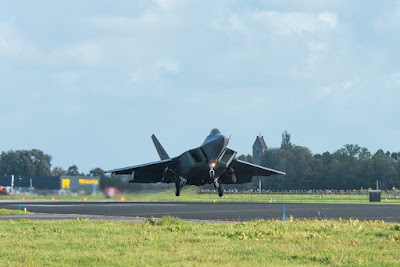Fifth Generation Integration at Leeuwarden Air Base, Netherlands
 |
| US and Dutch fifth generation fighters prepare to take off at Leeuwarden Air Base, Netherlands. |
The forward deployment to the Netherlands was led by Major Brenden "Heisman" Torphy, who was the Director of Operations for the 90th Expeditionary Fighter Squadron (90 EFS). Brenden has over 1,300 flight hours on the Raptor and he has a total of 1,800 total flying hours.
We had roughly 35 members supporting the forward deployment including pilots, maintenance and other support roles according to the major. The aim of the 90 EFS participation in the forward deployment to the Netherlands was to conduct Agile Combat Employment and to integrate and train with both Dutch and American F-35s. We also participated in Steadfast Noon alongside NATO Allies to enhance interoperability and build a stronger Trans-Atlantic link. Collaborating and integrating on Agile Combat Employment (ACE) or during big exercises alongside our NATO Allies and other fifth generation aircraft improves the resilience and survivability of coalition airpower throughout the European theater.
During the missions the Americans flew every day while in the Netherlands, sometimes even twice a day. Brenden said we had the opportunity to fly with the Royal Netherlands Air Force F-35A units. Next to that also the United States Air Force participated with F-35A Lightning II and F-15E Strike Eagle aircraft both coming from the 48th Fighter Wing from RAF Lakenheath United Kingdom. Training and integrating with other fifth generation aircraft provides our pilots the opportunity to react, respond to, and train to a higher level against an aircraft with advanced capabilities, providing a realistic threat environment. Just as threats have evolved, so has our fifth generation capabilities, training, and interoperability according to the major.
During the scenarios several types of missions were flown. We mainly trained Defensive Counter Air missions (DCA) and some Offensive Counter Air missions (OCA) on the final training flight. DCA is defined as defensive measures designed to detect, identify, intercept, and destroy or negate enemy forces attempting to penetrate or attack through friendly airspace. OCA includes attack operations, sweep, escort flights, and Suppression of Enemy Air Defense (SEAD). During all these missions tanker support was available from both the American and European partners. In scenarios like during the exercise Steadfast Noon all these aspects of flying are coming together.
VIDEO
👉 You may also like: USAF F-22 Raptors fly alongside allied fighters over Poland
Photos: Alex van Noije and Capt Waldo (90EFS PAO)
Video: Alex van Noije












No comments
All comments related to the contents of our articles are welcome. It is not allowed to post promotional messages, links to external sites, or references to activities not related to this blog.